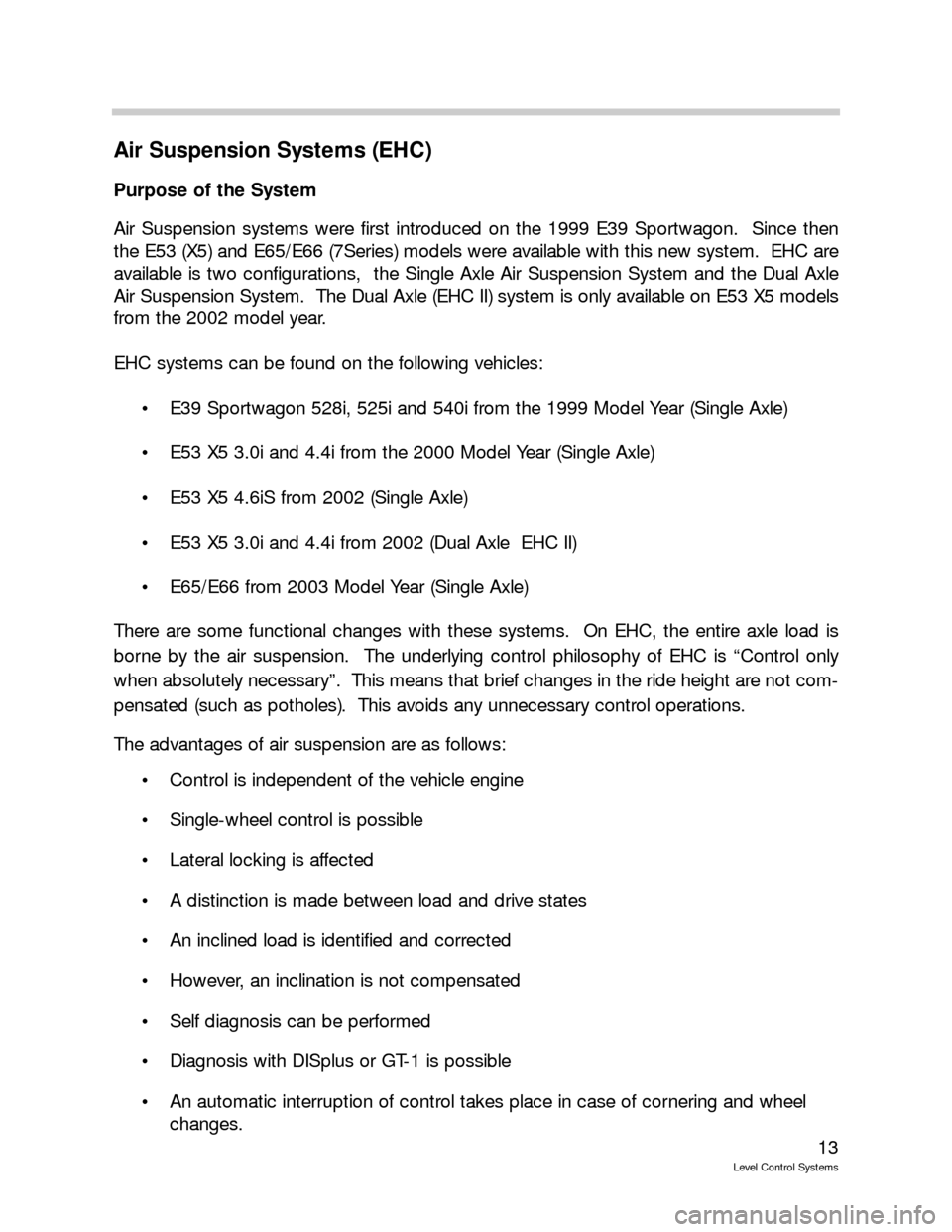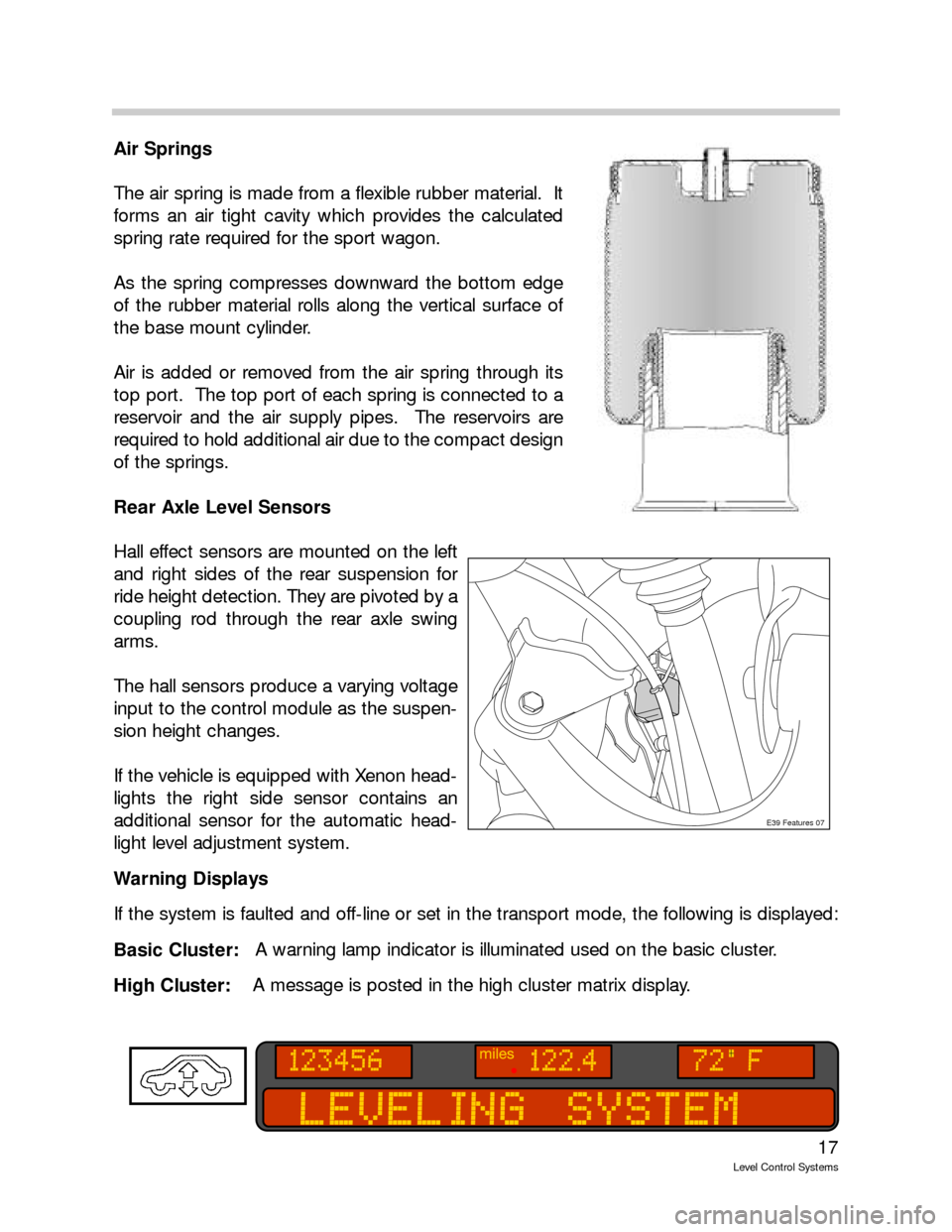2003 BMW 760LI Automatic
[x] Cancel search: AutomaticPage 13 of 57

13
Level Control Systems
Air Suspension Systems (EHC)
Purpose of the System
Air Suspension systems were first introduced on the 1999 E39 Sportwagon. Since then
the E53 (X5) and E65/E66 (7Series) models were available with this new system. EHC are
available is two configurations, the Single Axle Air Suspension System and the Dual Axle
Air Suspension System. The Dual Axle (EHC II) system is only available on E53 X5 models
from the 2002 model year.
EHC systems can be found on the following vehicles:
E39 Sportwagon 528i, 525i and 540i from the 1999 Model Year (Single Axle)
E53 X5 3.0i and 4.4i from the 2000 Model Year (Single Axle)
E53 X5 4.6iS from 2002 (Single Axle)
E53 X5 3.0i and 4.4i from 2002 (Dual Axle EHC II)
E65/E66 from 2003 Model Year (Single Axle)
There are some functional changes with these systems. On EHC, the entire axle load is
borne by the air suspension. The underlying control philosophy of EHC is “Control only
when absolutely necessary”. This means that brief changes in the ride height are not com-
pensated (such as potholes). This avoids any unnecessary control operations.
The advantages of air suspension are as follows:
Control is independent of the vehicle engine
Single-wheel control is possible
Lateral locking is affected
A distinction is made between load and drive states
An inclined load is identified and corrected
However, an inclination is not compensated
Self diagnosis can be performed
Diagnosis with DISplus or GT-1 is possible
An automatic interruption of control takes place in case of cornering and wheel
changes.
Page 17 of 57

17
Level Control Systems
Air Springs
The air spring is made from a flexible rubber material. It
forms an air tight cavity which provides the calculated
spring rate required for the sport wagon.
As the spring compresses downward the bottom edge
of the rubber material rolls along the vertical surface of
the base mount cylinder.
Air is added or removed from the air spring through its
top port. The top port of each spring is connected to a
reservoir and the air supply pipes. The reservoirs are
required to hold additional air due to the compact design
of the springs.
Rear Axle Level Sensors
Hall effect sensors are mounted on the left
and right sides of the rear suspension for
ride height detection. They are pivoted by a
coupling rod through the rear axle swing
arms.
The hall sensors produce a varying voltage
input to the control module as the suspen-
sion height changes.
If the vehicle is equipped with Xenon head-
lights the right side sensor contains an
additional sensor for the automatic head-
light level adjustment system.
Warning Displays
If the system is faulted and off-line or set in the transport mode, the following is displayed:
Basic Cluster:A warning lamp indicator is illuminated used on the basic cluster.
High Cluster: A message is posted in the high cluster matrix display.
E39 Features 07
Page 27 of 57

27
Level Control Systems
Two Axle Air Suspension (E53 EHC II)
Purpose of the System
The two axle air suspension system (EHC2) offers advantages over the single-axle air sus-
pension with respect to ride comfort and off-road capability.
Lowering the entire body makes it easier to enter, exit, load and unload the vehicle.
The vehicle's off-road capability was improved by providing the possibility for increasing the
ground clearance of the body.
The driver can now choose between three different ride levels which can be set with a rock-
er switch, as required. Automatic ride-height control for payload compensation and
automatic inclination compensation continue to be fitted.
D De
ef
fi
ic
ci
it
ts
s
o
of
f
t
th
he
e
o
ol
ld
d
s
sy
ys
st
te
em
m
The automatic payload compensation facility for the single-axle air suspension did not per-
mit driver control. The driver could not actively control the system to make it easier to enter
and exit or load the vehicle.
Ride level was compensated via the rear axle only.
A Ad
dv
va
an
nt
ta
ag
ge
es
s
o
of
f
t
th
he
e
n
ne
ew
w
s
sy
ys
st
te
em
m
The new system allows the ride-height control system to be controlled actively by the dri-
ver.
The twin axle air suspension allows both axles to be lowered evenly and in parallel.
As a result, it is easier for the occupants to enter, exit, load and unload the vehicle.
On the E39, the load of the complete rear axle was born for the first time by air suspension
in combination with the optional ride height control system. The system was controlled
automatically under all operation conditions, and there was no possibility for driver inter-
vention on the X5, the rear axle previously had single axle air suspension only. The air sup-
ply unit and the control unit were adopted from the E39. The air springs were adapted to
the X5.
There is a standard version and a sports version.
The ride-height control system (EHC) was supplied as standard in combination with the
M62 engine and is available as an optional extra in combination with the M54 engine.
EHC2 is optional on both the M62 and M54 versions of the X5 and not available on the
4.6is X5.
Page 35 of 57

35
Level Control Systems
Principle of Operation
Ride Height Control Operations
In addition to the automatic ride-height control system for payload compensation, the dri-
ver can set three different vehicle ride heights.
Off-road (+25 mm), high ground clearance to a max. speed of 50 km/h
Standard (0 mm), normal ride level
Access (-35 mm), for entry and exit, loading and unloading to a max. speed of 35 km/h
or can be activated in Standard mode at road speeds < 25 km/h
The various heights are selected by scroll rocker. Light emitting diodes indicate the present
ride height setting.
Ride height can be adjusted from terminal 15 and with the doors closed. The hood and tail-
gate may be open.
The system also controls inclination automatically, like the single axle air suspension.
All control operations are executed without stopping at intermediate levels. The vehicle is
configured pneumatically in such a way that the front and rear axles can be lowered in par-
allel in any load situation. Depending on the load situation, either the front axle or the rear
axle is slightly quicker. On account of the different control speeds, a difference in height
between the two axles is possible during all control operations. If a max. permissible thresh-
old is exceeded, the quicker axle is stopped briefly.
The various levels can be preselected while travelling. Changeover between ride levels is
effected at the speed threshold values defined in the control unit. The control unit monitors
the change-over.
As soon as the driver sets a new target ride level by pressing a button or when a change-
over is initiated automatically by a specific driving condition, the LED for the current ride
level remains lit and the LED for the target ride level begins to flash.
When the new level is reached, the LED for the previous level goes out and the LED for the
new level reached stays lit permanently.
Page 36 of 57

36
Level Control Systems
The various levels can be preselected while travelling. Changeover between ride levels is
effected at the speed threshold values defined in the control unit. The control unit monitors
the change-over.
As soon as the driver sets a new target ride level by pressing a button or when a change-
over is initiated automatically by a specific driving condition, the LED for the current ride
level remains lit and the LED for the target ride level begins to flash.
When the new level is reached, the LED for the previous level goes out and the LED for the
new level reached stays lit permanently.
If a ride level selection is not allowed, the LED indicating the momentary ride level of the
vehicle flashes for 3 seconds.
A special case is preselection of Access levels while travelling. The Access LED flashes and
the LED for the original ride level is lit permanently. However, this does not mean that a con-
trol operation has already begun. The control operation does not actually begin until the
speed threshold which the Access level allows is reached or undershot.
Off-Road
(+25 mm)
Standard
(0 mm)
Access
(-35 mm)
Up button
and
<50km/h
Up button
or
>35km/h Up button
or
60 s time period
Access
Preselection
<25km/h Down Button and
<80km/h
and
Accumulator pressure
>threshold
and/or
compressor temperature
or
>50km/h